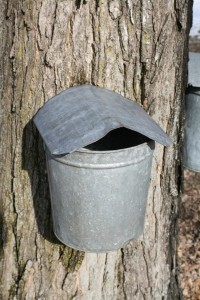The north-country is full of sweet rumor. Driving the backroads at this time of year, you look up from the challenge of deep mud and see occasional shacks or smallish barns billowing steam. Then, you roll down the window and breathe in the sweetened air. It’s sugar time in the woods.
Or, more accurately, sap time, and this year’s run of cold nights and sunny days, salted by occasional snows, has set up a classic season for maple sap and syrup. To be sure, most sugar-bushes look markedly different from their ancestors, whose trees featured gray metal buckets, slung from hooks beneath taps inserted into drill holes in those trees, the whole bush also laced with the tracks of trudgers (sometimes horses) dragging a collecting vat from tree to tree, gathering the sap. Today’s sugar bush is webbed with plastic tubing, often in bright colors, and these veins shunt the sap from tree to tree, ever-down toward a collecting point, often the sugar house itself, where they drip into containers prior to the boiling.
Still, the old buckets with their shallow triangular hats persist in places, often as small family operations that make syrup and sugar for personal use and gifts. These little sugarers, with steam rising from a shed out back or from a vent over the kitchen stove, are my favorites. They cast me back to when I was a little sugarer too.
In my early 20s, I spent a winter in a wood-heated, old farmhouse near the end of a dirt road in west-central New Hampshire. Uncertain about my future, I’d decided on a writing-winter, but really it had turned into a wandering winter, where my scripts were snowshoe tracks into the various corners of the valley and ridges above. I learned a lot and wrote little.
As spring neared, pails appeared on the row of maples that lined the dirt road. A farm family in town had asked for and received permission to tap these roadside trees, and, every so often, I began to lift the bucket’s lids and check on the sap levels. After a few days, I noticed that many of the buckets were full, and I figured the collecting truck, a sort of small tanker, would be there to gather the bounty soon. A day passed. No tanker. The buckets dripped steadily with overflow now eroding the collars of snow below.
Living at road’s end had made me a bit of a scrounge, and now I did what any good scrounge would do: I got a big bucket, took my ladle from beside the water-pump and began to skim ladlefuls from the overflowing buckets. This went on for some days, and by then, I had gallons of sap.
What to do? Time, surely, to fire up the cookstove and break out the broad turkey pan and do some boiling. I had a lot of wood, a lot of time, and, even when the tree-tapper emptied his pails, I soon had a lot of overflow.
For the next two weeks, I made syrup of varying intensities. Those who know anything about making maple syrup will recognize the oft-cited 40 to 1 ratio of sap to syrup. In short, it takes a lot of sap and boiling to make sweet immersion for your pancakes. What may be less known is the sweet world a room or house becomes if you do your boiling indoors. Saphouses are well-vented, outdoor enterprises for a reason.
Still, I got used to the always-sweet, humid air, and, aside from a little crystallized sugar on the beam above the stove, the old farmhouse seemed to adapt too. Entering the house from a day of woods wandering, or from some bucket-skimming was like coming into a large maple confection. And as the sap boiled down from water-clarity to various shades of amber, I began to eat only foods that called for syrup. I became, in short, a sort of sugar bear.
By March’s end, I had a couple of gallons of dense amber syrup. A few, hand-labeled quarts went for gifts. And, when I left the valley as spring came on, I carried the rest with me as the sweet writing of maples.


One response to “The Sweet Season – Revisited”